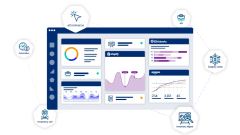
As a small or medium-sized business (SMB) product business, staying afloat is a challenge. Your team members, many of whom are likely wearing multiple hats, are busy doing everything in their power to ensure your customers are efficiently and accurately served while making a profit in the process.
Every part of running a business is important, but there’s one that stands out above the rest: financial reporting. Financial reporting is how you track your current and future financial performance, communicate with your key shareholders and investors, make wise—and informed—financial decisions, and remain compliant with all tax regulations.
It’s not the most invigorating (nor the easiest) aspect of being in business, but it is mandatory, which is why today we’re providing four complimentary financial reporting templates you can use to keep your business running smoothly. And we’ll explain why these financial reports matter, what their key elements are, and how best to use them.
1. Trial Balance Template
A trial balance report is a report you create before finalizing your financial statements. This pre-report summarizes all general ledger accounts and tracks whether the total credits and debits of a specific period balance out. The information contained in the trial balance report helps you catch any bookkeeping errors before you prepare your final financial statements.
Trial balance reports include:
- The trial balance period
- Account names (e.g., Cash, Accounts Receivable, Inventory, Accounts Payable)
- Debit balances
- Credit balances
- Total calculations
To ensure accurate financial statements, make sure you’re regularly updating the trial balance report and reconciling it with the general ledger. Below is an example Trial Balance Sheet.
|
Trial Balance Sheet |
||
|
Trial Balance for the period: |
||
| 01 Jan 2024 31 Dec 2024 | ||
|
Account |
Debit |
Credit |
|
Cash |
45,000 |
|
|
Accounts Receivable |
35,000 |
|
|
Inventory |
120,000 |
|
|
Furniture and Equipment |
30,000 |
|
|
Accounts Payable |
35,000 |
|
|
Loans Payable |
50,000 |
|
|
Capital |
60,000 |
|
|
Retained Income |
50,000 |
|
|
Sales |
250,000 |
|
|
Cost of Goods Sold |
150,000 |
|
|
Salaries Expense |
40,000 |
|
|
Rent Expense |
15,000 |
|
|
Utilities Expense |
5,000 |
|
|
Advertising Expense |
5,000 |
|
|
Total |
445,000 |
445,000 |
2. Profit and Loss (P&L) Statement Template
Also known as an income statement, a profit and loss (P&L) statement allows you to see your income and expenses over a specified period. It’s issued both quarterly and annually and shows how much profit, and sadly, how much loss your business is generating.
With a P&L statement, you have your revenue minus your costs and expenses in an easily understood format. This equips you with the knowledge you need to identify cost-saving opportunities and to set realistic sales goals, thus helping improve your overall financial health.
Each P&L statement provides the following elements:
- Sales Revenue: Total amount of money made selling products or services over a specified time.
- Cost of Goods Sold (COGS): How much it costs to produce a product using only direct costs (e.g., raw materials, labor, etc.).
- Gross Profit: The amount of profit made after subtracting COGS from sales revenue.
- Operating Expenses: Costs associated with daily operations, such as rent, utilities, salaries, taxes, marketing, and more.
- Net Income: The amount of money left after taking out all expenses from revenue.
For the best results, you’ll want to compare your P&L statements monthly or quarterly to track trends and adjust your strategies. Note that a P&L statement doesn’t comply with any specific accounting and reporting requirements, which vary by country.
Check out the following P&L report example:
|
Profit & Loss |
|
|
Profit & Loss for the period: |
|
|
01 Jan 2024 31 Dec 2024 |
|
|
Item |
Amount |
|
Sales Revenue |
250,000 |
|
Cost of Goods Sold |
(150,000) |
|
Gross Profit |
100,000 |
|
Operating Expenses |
|
|
Salaries Expense |
40,000 |
|
Rent Expense |
15,000 |
|
Utilities Expense |
5,000 |
|
Advertising Expense |
5,000 |
|
Total Operating Expenses |
(65,000) |
|
Net Profit |
35,000 |
3. Balance Sheet Template
A balance sheet is a crucial financial report that provides a business’s assets, liabilities, and owner’s equity based on a specific date. It basically takes a snapshot of your financial position, helping you assess your overall financial stability and liquidity.
Like the P&L statement, the balance sheet is not designed to meet accounting or reporting requirements but is used to highlight where you stand financially at any given point. By reviewing this information regularly, you’ll be able to make better, more accurate financial planning and investment decisions.
In a balance sheet, you’ll find:
- Assets (current and non-current)
- Liabilities (short-and-long-term)
- Equity
Here’s a Balance Sheet example:
|
Balance Sheet |
|||
|
Balance Sheet |
|||
|
as at 31 December 2024 |
|||
|
Assets |
Amount |
Liabilities & Equity |
Amount |
|
Current Assets |
Current Liabilities |
||
|
Cash |
45,000 |
Accounts Payable |
35,000 |
|
Accounts Receivable |
35,000 |
||
|
Inventory |
120,000 |
||
|
Non-Current Assets |
Non-Current Liabilities |
||
|
Equipment |
30,000 |
Loans Payable |
50,000 |
|
Equity |
|||
|
Capital |
60,000 |
||
|
Retained Earnings |
50,000 |
||
|
Profit for the Year |
35,000 |
||
|
Total Assets |
230,000 |
Total Liabilities & Equity |
230,000 |
4. Cash Flow Statement Template
How much money you generate (inflow) and how much you spend (outflow) is found in your cash flow statement. When used in conjunction with your P&L and balance statements, your cash flow statement provides you with a comprehensive look at how your business is performing financially. It also helps you manage your cash reserves and avoid liquidity issues, such as not having enough cash to meet your short-term financial obligations.
The cash flow statement covers:
- Operating Cash Flow (OCF): Cash received due to operating activities.
- Investing Cash Flow: Cash used for investment purposes (e.g., buying property, equipment, etc.
- Financing Cash Flow: Cash raised from finance activities related to debt, equity, and dividends.
- Net Cash Position: Amount of cash available after taking liabilities into account.
With cash flow reports (like the example below), you’ll have a firm grip on cash flow trends, which will help you take the steps you need to guarantee a strong, profitable future.
|
Cashflow |
|
|
Item |
Amount |
|
Cash Flow from Operating Activities |
|
|
Net Profit |
35,000 |
|
Adjustments for non-cash items |
|
|
Changes in working capital |
|
|
Increase in Accounts Receivable |
(25,000) |
|
Increase in Inventory |
(80,000) |
|
Increase in Accounts Payable |
35,000 |
|
Net Cash from Operating Activities |
(35,000) |
|
Cash Flow from Investing Activities |
|
|
Purchase of Equipment |
(30,000) |
|
Net Cash from Investing Activities |
(30,000) |
|
Cash Flow from Financing Activities |
|
|
Proceeds from Loans Payable |
50,000 |
|
Owner's Investment |
60,000 |
|
Net Cash from Financing Activities |
110,000 |
|
Net Increase in Cash |
45,000 |
|
Cash at beginning of period |
0 |
|
Cash at end of period |
45,000 |
What Happens When You Outgrow Templates? You’ve Got Cin7!
According to a recent report by digital and email marketing platform Constant Contact, SMBs in today’s market are feeling optimistic but realistic about growth opportunities in 2025.
Constant Contact spoke with 1,600+ SMBs from Australia, Canada, the UK, and the US that have been in business less than five years and found that 55% were feeling a “bit unsure” about external challenges (such as economic factors) but 45% see growth happening in 2025. You may not be a new SMB, but you’re hoping to see this growth for yourself, and these basic but helpful accounting templates can help you do it.
But what happens if you outgrow these templates? You turn to technology, like Cin7.
Constant Contact’s report indicates that 91% of new business owners consider technology essential to their success, and at Cin7, we’ve designed our technology to meet all your financial reporting needs.
Cin7 is complete inventory management software (IMS) that lets you manage your inventory, warehouse, and sales requirements within a single, unified system. With Cin7, you can assess as well as improve your financial health by utilizing our seamless integration with accounting software solutions QuickBooks Online (QBO) and Xero.
You’ll have real-time data and insights in one place along with the vital financial reports required to keep your financial information updated and accurate, which ultimately allows you to make the best decisions for your business.
To learn more about how we can automate your financial tracking, eliminate manual errors (while saving you time through the automated pulling and creating of financial reports), and enabling you to scale easily, request a free demo today.
More from the blog
View All Posts
The value of reporting for SMBs: How Cin7 empowers smarter decisions
Read More
4 factors to choosing a high-performing software implementation expert
Read More


